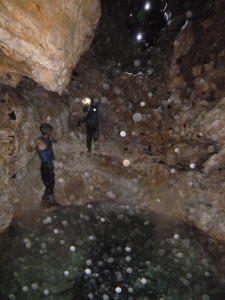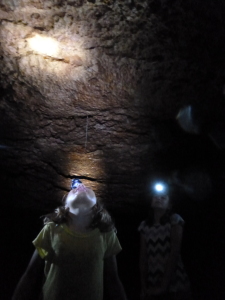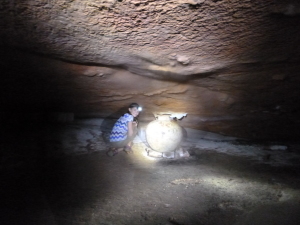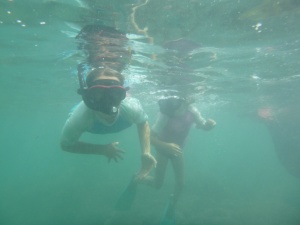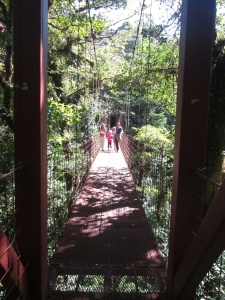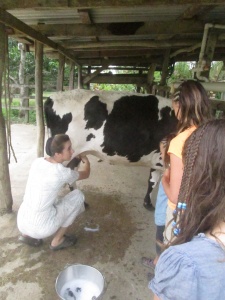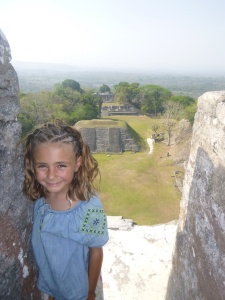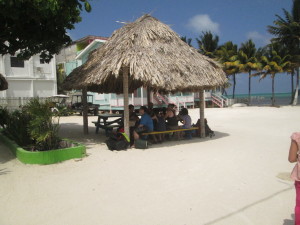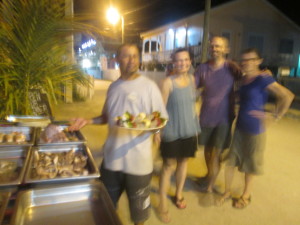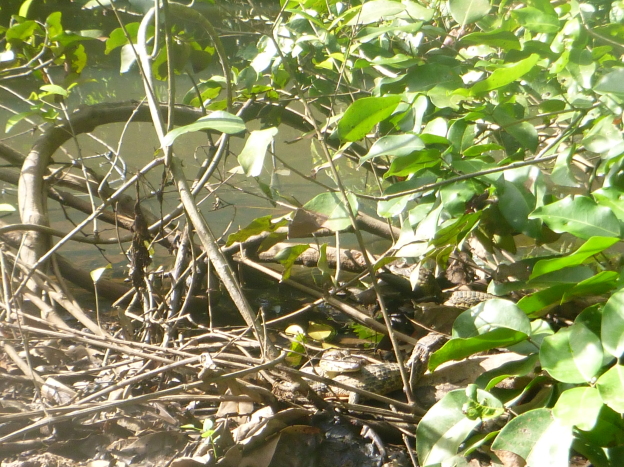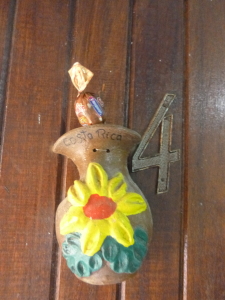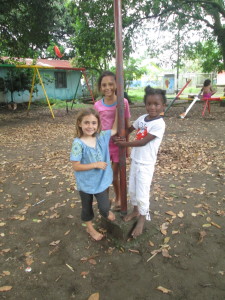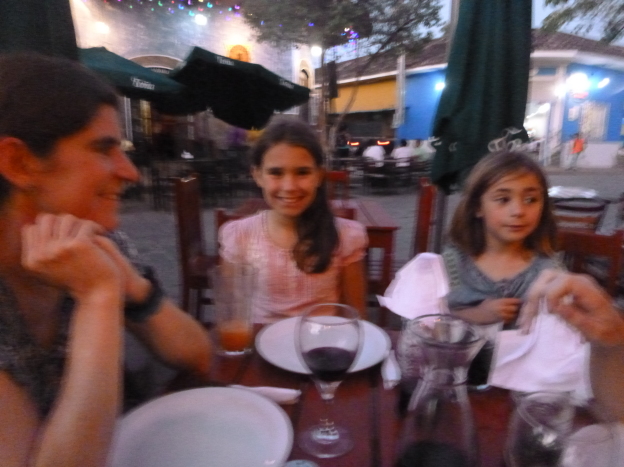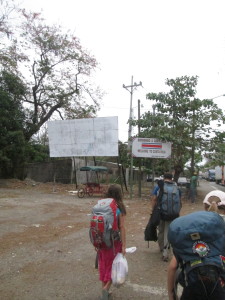There are many ways to view this trip.
Here at the Cave’s Branch Jungle Lodge, during the final days of our journey, I’ve started to think of it as an ice cream sundae. Our journeys through Nicaragua and Costa Rica were each large scoops of different flavored ice cream. The week in Caye Caulker was a generous dose of hot fudge sauce. Cool-M farm was a generous dollop of whipped cream.
And this place is the cherry on top.
It is also a curious bookend to the experience that began this whole journey, our two weeks at La Mariposa school in Nicaragua. Both places emphasize experiential learning and communal meals. In neither place are we meant to feel like mere tourists. At the school we were students of Spanish; here we are adventurers who want to get away from comforts and into the wilderness.
The “away from comforts” part is not entirely accurate. The Caves Branch Lodge brochure stresses that the lodge does not sanitize the experience of being in the jungle. This is true, inasmuch as our cabana suite is virtually free of walls, instead relying on knee-height-to-ceiling screens to keep the bugs out. All the sounds of the surrounding landscape, be they pleasant or jarring, come through loud and clear. But the accommodations are extremely clean and nice, the indoor and outdoor showers are luxurious, and the daily towel origami has not lost its charm even after four nights here.
The lodge and guest houses are surrounded by a well-manicured, expertly designed jungle garden. There are many established trees of various varieties with an under-canopy containing an amazing collection of useful plants. Our walk from the pool to our cabana brings us past a cacao tree, an allspice bush, and a tree of the type that inspired and was used to produce Chanel No. 5. We also pass a small structure that houses dozens and dozens of varieties of orchids, including the one that produces vanilla beans. It’s very beautiful and educational, but not virgin forest brimming with wild animals — even if they do warn us to look out for snakes in the paths on our way back from dinner.
.
The dinners are communal and pleasant. We have even struck up quite a friendship with a family from Massachusetts (it seems like all the guest here are from either New England or Colorado) whom we plan to keep in contact with once we get home. But the dinners feature four courses and multiple options — usually three types of meat, plus a fish option. It seems like overkill compared to our single-plate, home-sourced Mariposa dinners. The kids are not complaining, but I don’t think Jen and I will feel hungry for a few weeks.
As for the adventures, they have lived up to the billing. During our first two weeks in Central America, our Spanish classes drained us mentally and gave us a bridge to the culture we were about to immerse ourselves in. The Caves Branch adventures have challenged us physically and ratcheted up our adrenaline, while transporting us to places we’d never imagined we’d get to see.
Zoe called the shots in this area, proclaiming her desire to do the two most vigorous of the activities offered (our package deal here allows us three adventures). Once Lanie got the ok from the staff, we all followed Zoe’s lead.
So we found ourselves in helmets and headlamps climbing up underground waterfalls with cold, clear water splashing all around — and over — us. Then we leaped back down into the pools below. There was even one technical climb that required harnesses and ropes. The climb itself wasn’t difficult, but it was tough looking up for your next handhold with a waterfall plunging down into your face.
Three hours tramping around in a dark, wet cave (plus a half-hour for lunch on a huge flat rock)? No problem. We had a good group, good guides, and the kids are in good shape for adventuring. Hector the guide seemed to feel that Lanie needed a piggy back ride once in a while, but she was scrambling over rocks on her own two feet. It is probably good that our other guide Arnold took Lanie on his back when he did the big jump off the highest waterfall. (Or it’s highly possible that we’re the worst parents ever for putting our kid — and our guide — through this. Where would we be if we weren’t questioning our sanity? Not in a cave.)
The next day was meant to be a rest day. We selected the cave tubing adventure, which is only rated for three sweat beads in the catalog (our other two adventures are rated for the full five six sweat beads). This adventure turned out to be a nice combination of our waterfall cave adventure — because we got very wet– and the ATM cave tour we took in San Ignacio — because we saw lots of Mayan relics.
In fact, the the historical elements of this cave rivaled those of the ATM cave. There was an awesome altar to the fertility god and a huge intact pot that we could walk right up to. No human remains, though. That’s why ATM gets all the limelight. But it still doesn’t have a monopoly on skeletons. The parents from the family we befriended took a tour of a different, dry cave that had human remains. (Their daughter accompanied us for the tubing.) They said their tour was cool.
No doubt it was. For one thing, people here tend to leave artifacts where they find them in the caves. The above-ground Mayan sites have been pillaged by locals and by early 20th-century archaeologists alike. The cave sites are more difficult to access (good luck trying to get in without helmet, headlamp and a pretty good idea of where you’re going — and even more good luck trying to get out). They were discovered many decades later than the cities, and the trend among those studying the sites now is to disturb them as little as possible.
Plus, there just seems to be an incredible amount of cool things in a relatively small area here. All three of our tours took place in the hills surrounding a single, innocuous-looking orange orchard.
Our bloodthirsty friends’ human sacrifice cave tour was in those hills, too. (Just kidding. They probably aren’t all that bloodthirsty.) That’s a lot of amazing stuff inside an area of a square mile or two, all of it a 10-minute drive from our lodge.
This has to do with geology. The hills are primarily limestone remains of ancient coral reefs. Rivers, the Cave Branch River among them, carve out cavities all through these hills. Ground water seeps in and dissolves minerals that eventually settle out as fantastic cave formations. The Mayans encounter the caves and take them for the entrance to the underworld, the realm of their gods, and the source of human existence.
Voila! The stage is set for adventure.
For our last trip we stayed above the ground, working on top of a cave that had collapsed creating a giant sink hole. Our task for the day was to hike a mile or so into the jungle to the edge of the sinkhole and rappel down to the bottom. The bottom was only 300 feet below. Jen calculated that to be about a 30-story building.
Zoe and Nadia were stalwart and somewhat stoic as they went over the edge. Lanie giggled nervously and tittered, “Oh, my gosh!” as she was lowered over (Lanie was lowered the whole way by rope from above, the rest of us used our hands and climbing equipment to lower ourselves — we were all also connected to the top by a separate safety rope managed by a guide). Jen steadfastly tried to lean back as advised, despite every rational instinct to not lean back near the edge of a 300-foot sink hole, and groaned, “I looked down. That was a mistake.”
I felt my breathing and heart rate accelerate to that of a cute little tiny bunny rabbit, times about a thousand.
But we all made it down, sorry to douse the suspense. I had planned to take pictures of Jen as we rappelled together, but I could not work the camera with my thick leather gloves on and I was not capable of contemplating taking my gloves off to make the camera work. We’ll have to rely on the pictures our guide Marvin took from the top and those the girls took from the bottom.
How’s that for adventure. We even got a day off to linger around the lodge before it was time to pack up and leave. That meant access to the pools, some time to catch up on blogging, a few trips to the bar for alcoholic and non-alcoholic concoctions from Anthony the bartender (drinks were included in our package as long as we stuck with the local labels and refrained from anything that required the blender and, strangely, Gatorade).
By evening a family of howler monkeys had settled into a tree above the pools, we had gotten in a few rounds of the games we’ve lugged around for almost three months, and Nadia showed off her steadily increasing ping pong skills.
After one more four-course meal it was time to settle in for the seventy-seventh straight — and final — night in a bed that wasn’t our own.




